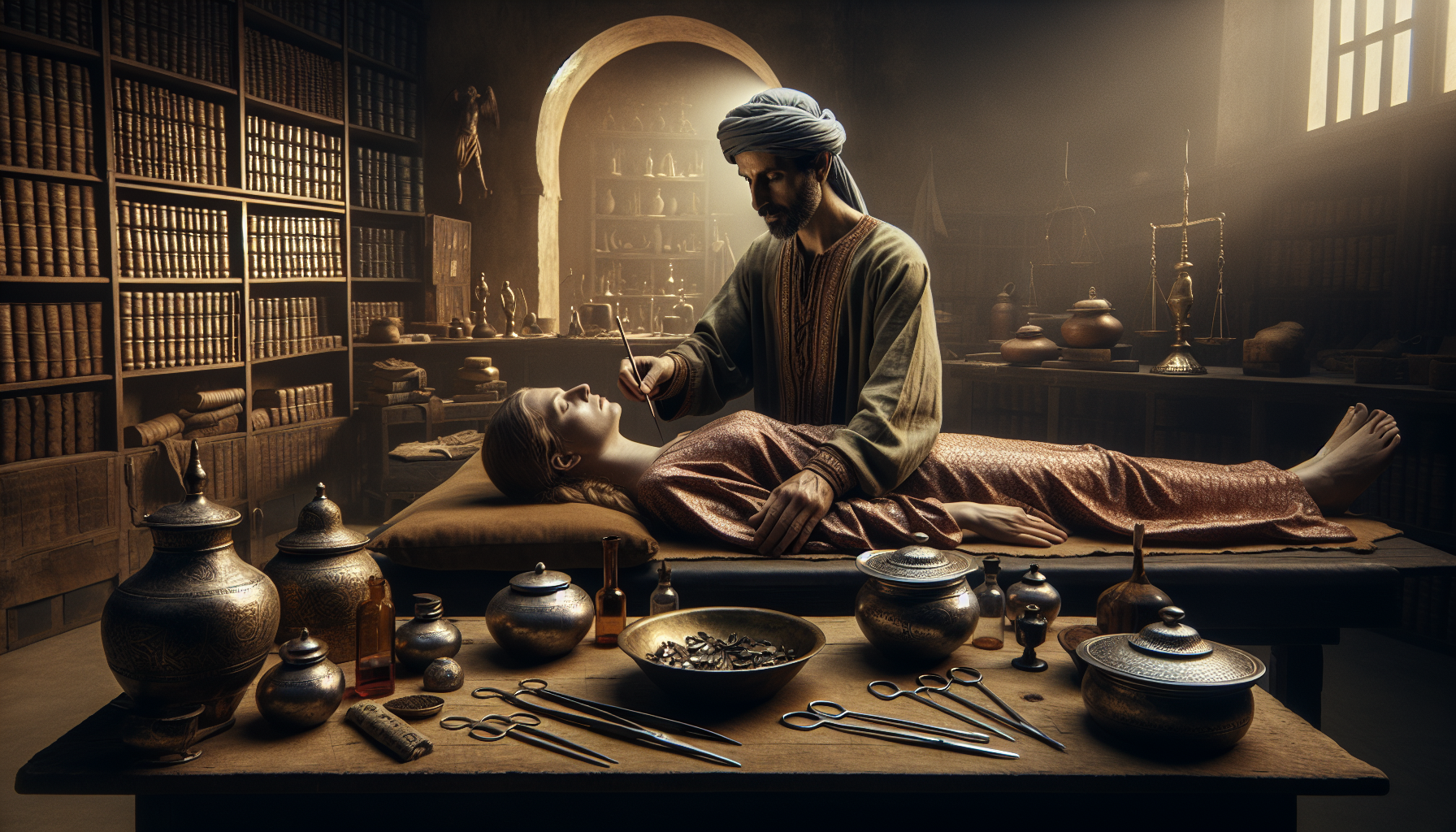In a world where modern medicine often reigns supreme, the idea of turning back to ancient practices for health solutions might seem like a step backwards. Yet, as we delve into the fascinating realm of historical healing techniques, we uncover a treasure trove of wisdom that has stood the test of time. Among these age-old practices is the art of bloodletting, a method once revered for its supposed ability to balance the body’s humors and restore health. 🌿 This might sound peculiar, perhaps even arcane, to our contemporary sensibilities. However, understanding the cultural and historical significance of bloodletting can provide us with profound insights into how ancient civilizations viewed the human body and its intricate workings.
Bloodletting was not merely a medical procedure; it was an embodiment of a worldview. This practice, which involved the withdrawal of blood to cure or prevent illness and disease, was grounded in the ancient Greek theory of humorism. According to this belief, our health and temperament were governed by four bodily fluids: blood, phlegm, yellow bile, and black bile. Each humor was linked to specific organs and elements, and an imbalance among them was thought to be the root of all ailments. To achieve a harmonious balance, physicians of the time turned to bloodletting as a primary remedy. 🩸 The procedure’s application spanned centuries, crossing the boundaries of continents and cultures, finding a place in the annals of Chinese, Egyptian, and European medical traditions.
But what can this ancient practice teach us today? In an era dominated by pharmaceuticals and cutting-edge technology, it’s worth exploring the broader implications of bloodletting and the holistic principles it embodies. Our journey through this article will unravel the origins of bloodletting, charting its evolution from a common therapeutic intervention to a historical curiosity. We’ll examine the philosophical underpinnings of humorism, shedding light on how ancient societies perceived health and disease. Furthermore, we’ll navigate the transition of bloodletting from a mainstream practice to its eventual decline, reflecting on the lessons that modern medicine can glean from its legacy.
The Origins and Evolution of Bloodletting
Bloodletting, an ancient practice rooted in the quest for restoring balance within the body, has been a cornerstone of medical treatments across various cultures for thousands of years. The origins of bloodletting can be traced back to ancient civilizations such as Egypt, Greece, and Mesopotamia, where it was believed that the body was composed of four humors: blood, phlegm, black bile, and yellow bile. These humors needed to be balanced for optimal health. The imbalance of these humors was thought to cause disease, and bloodletting was a primary method to correct this imbalance. Over time, the practice evolved through the hands of different cultures and medical practitioners, each adding layers of complexity and understanding to the technique.
In ancient Greece, the renowned physician Hippocrates was among the first to formalize the concept of humoral balance and its connection to health. His ideas laid the groundwork for future medical theories, including those of Galen, a Roman physician whose influence extended into the Middle Ages. Galen’s expansion of humoral theory reinforced bloodletting as a standard medical practice. He believed that blood was the dominant humor and that its excess needed to be regulated to maintain health. Bloodletting techniques varied, from venesection, the opening of a vein, to the application of leeches. These methods were adapted based on the patient’s condition, the season, and even astrological signs.
As medical knowledge advanced through the centuries, bloodletting maintained its prominence, though it faced increasing scrutiny. By the time of the Renaissance, medical practitioners began to question its efficacy. Despite the growing skepticism, bloodletting persisted as a standard practice well into the 19th century. The gradual decline of bloodletting’s popularity can be attributed to the rise of scientific medicine, which offered alternative explanations for disease and more effective treatments. However, the historical significance of bloodletting and its impact on the development of medical theories cannot be overstated. It paved the way for understanding the circulatory system and the role of blood in health and disease.
Table of Bloodletting Practices Through History
| Era | Region | Method | Purpose |
|---|---|---|---|
| Ancient Egypt | Middle East | Venesection, Leeches | Balance humors |
| Classical Greece | Europe | Venesection | Balance humors, treat fever |
| Middle Ages | Europe | Leeches, Cupping | Prevent illness, treat various ailments |
| Renaissance | Europe | Venesection, Leeches | Treat disease, maintain health |
| 19th Century | Global | Venesection, Leeches | Varied applications |
Understanding the Humors: The Foundation of Bloodletting
The concept of the four humors is central to the practice of bloodletting and serves as its philosophical backbone. According to ancient medical theories, these humors—blood, phlegm, black bile, and yellow bile—corresponded to the four elements: air, water, earth, and fire. Each humor was associated with specific physical and personality traits, and the balance among them was believed to influence an individual’s health and temperament. For example, an excess of blood was thought to cause a sanguine temperament, characterized by sociability and optimism, but also predisposed to fever and inflammation.
To further elaborate, let’s consider the role of each humor individually. Blood, associated with the element of air, was believed to be hot and moist. It was linked to vitality and a lively personality. Phlegm, linked with water, was considered cold and moist, correlating with a calm, passive demeanor. Black bile, associated with earth, was cold and dry, thought to induce a melancholic temperament. Lastly, yellow bile, associated with fire, was hot and dry, and those with an excess were considered choleric—prone to anger and ambition. The interplay among these humors dictated not only physical health but also psychological states, providing a comprehensive framework for diagnosing and treating ailments through bloodletting.
Techniques and Tools of Bloodletting
Throughout history, the tools and techniques of bloodletting have evolved, each iteration reflecting the prevailing medical knowledge and cultural beliefs of the time. Initially, the practice involved simple tools such as sharpened stones and animal bones, which were used to make incisions and drain excess blood. As medical understanding progressed, more sophisticated instruments like lancets and fleams were developed to facilitate the procedure with greater precision and safety.
Leeches, a natural and effective tool for bloodletting, became widely used in various cultures. These small creatures were prized for their ability to draw blood painlessly and their anticoagulant properties, which allowed for controlled blood flow. The use of leeches was particularly popular in the 18th and 19th centuries, during which time they became a symbol of medical practice. Despite the advent of modern medical techniques, leeches continue to be used in certain surgical procedures today, illustrating their enduring utility.
Another notable technique was cupping, which involved placing heated cups on the skin to create suction and draw blood to the surface. This method was believed to promote healing by redirecting blood flow and expelling toxins. Cupping was practiced across many cultures, from ancient China to the Islamic world, and remains a popular alternative therapy in modern times.
Watch the video below to learn more about historical bloodletting tools and techniques:
Check out this video on YouTube: Historical Bloodletting Tools and Techniques – Channel History Chronicles
Modern Perspectives on Ancient Practices
In the contemporary world, the practice of bloodletting is largely viewed as an antiquated and scientifically unfounded medical procedure. However, the study of bloodletting offers valuable insights into the evolution of medical science and the cultural contexts that shaped its development. Understanding the historical significance of bloodletting helps modern practitioners appreciate the complexities and challenges faced by early healers and the foundations they laid for today’s medical advances.
Today, the principles underlying bloodletting are acknowledged as part of the history of medicine, serving as a reminder of the human quest for knowledge and understanding of the body. The practice has also sparked a renewed interest in traditional medicine and holistic health, encouraging a reevaluation of ancient wisdom in the context of modern scientific inquiry. While bloodletting itself may no longer be a standard treatment, its influence is evident in the ongoing exploration of the relationship between body, mind, and environment.

Conclusion
In wrapping up our exploration of the ancient practice of bloodletting, particularly its role in balancing the body’s humors, we’ve journeyed through a fascinating and complex aspect of medical history. This practice, deeply rooted in ancient civilizations, serves as a testament to humanity’s enduring quest to understand and manipulate the human body for health and wellbeing. From the Egyptians to the Greeks, and into the Middle Ages, bloodletting was seen as a critical tool for maintaining the balance of the four humors—blood, phlegm, black bile, and yellow bile—that were believed to govern health and disease.
Throughout our discussion, we’ve examined how ancient cultures developed intricate systems of medicine based on the observation of nature and the human body. We delved into the theories of prominent figures like Hippocrates and Galen, who were instrumental in shaping the practice of bloodletting within the framework of humorism. Their teachings emphasized the importance of equilibrium within the body, a concept that, although scientifically outdated today, underscores the historical significance of balance in health practices.
Additionally, we’ve explored the various methods of bloodletting, from venesection to cupping, and how these techniques were adapted over centuries. The evolution of these practices reflects a broader narrative of medical advancement and the shifting understanding of human physiology. While modern medicine has largely moved beyond humorism and bloodletting as a treatment modality, the historical context provides valuable insights into the evolution of medical thought and the perennial human desire to master the art of healing.
Understanding the cultural and historical backdrop of bloodletting also highlights the interplay between science and society. It reminds us of the importance of questioning prevailing medical paradigms and encourages continuous inquiry and skepticism—a mindset that fuels medical innovation and improvement.
Moreover, this journey through ancient medical practices invites us to appreciate the resilience and creativity of past civilizations. It offers a perspective on how far we’ve come and how these early practices, although primitive by today’s standards, laid the groundwork for modern medicine’s sophisticated approaches.
The importance of this topic extends beyond a mere historical curiosity. It prompts us to reflect on the evolution of medical practices and the cultural contexts that shape them. By revisiting these ancient traditions, we gain a deeper appreciation for the complex tapestry of human history and the shared pursuit of health across generations. It also challenges us to consider how future generations might view our current medical practices and what they might learn from our successes and mistakes.
As we conclude, it’s crucial to recognize the enduring lesson of adaptability in medicine. The story of bloodletting teaches us that medical practices are dynamic and that they evolve as our understanding of science and the human body deepens. This adaptability is a cornerstone of medical progress and underscores the importance of continuous learning and adaptation in the face of new evidence and discoveries.
We encourage you, our readers, to reflect on what you’ve learned and to consider how these historical insights might inform your understanding of modern health practices. Perhaps there’s something valuable in the ancient emphasis on balance that could enhance our contemporary approaches to health and wellness.
Let us continue to learn from the past as we build the future of health and healing. Your engagement in this journey is invaluable, and we thank you for being part of this exploration into the art and science of medicine. Together, let’s continue to unlock ancient wisdom for a healthier tomorrow. 🌿
To further your exploration, we recommend checking out additional resources and scholarly articles on the history of medicine. These insights will enrich your understanding and appreciation of how ancient practices continue to influence modern thought. Explore more through reputable sources such as the History of Medicine Division of the National Library of Medicine and the Wellcome Collection.
Toni Santos is a visual storyteller and conceptual archivist whose work explores the curious, often poetic ruins of pseudoscience and obsolete theories. With a reverence for forgotten frameworks and fantastical logic, Toni illuminates the imaginative spaces where science once drifted into myth, speculation, and symbolic belief.
His creative path is rooted in a fascination with the fringe — from phrenology maps to ether diagrams, hollow earth charts to animal magnetism illustrations. Each visual Toni creates or curates is an invitation to reexamine the strange beauty of discarded knowledge — not as failure, but as cultural reflection, as art born from our eternal desire to explain the unexplainable.
Blending visual design with historical inquiry, Toni gives new life to lost diagrams, metaphysical charts, and antique engravings that once shaped worldviews. His work occupies the liminal zone between fact and fiction, where obsolete models still pulse with philosophical resonance and forgotten charm.
As the mind behind Vizovex, Toni shares illustrated essays, curated collections, and visual reinterpretations that invite others to explore the aesthetic and symbolic value of outdated theories. His goal is not to validate, but to remember — to view these speculative systems as relics of human creativity, vulnerability, and yearning.
His work is a tribute to:
The elegance of error in the evolution of knowledge
The symbolic artistry of discarded explanations
The blurred lines between belief, observation, and imagination
Whether you’re a collector of curious ideas, a lover of forgotten diagrams, or someone drawn to the strange scaffolding of old worldviews, Toni opens a portal to a time when the universe was still full of ghosts, humors, and cosmic fluids — one chart, one symbol, one discredited wonder at a time.





